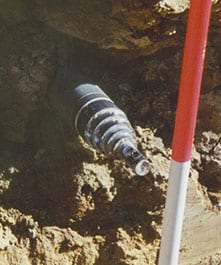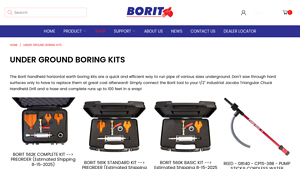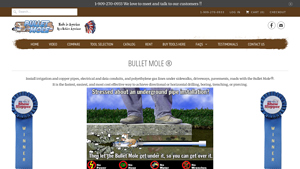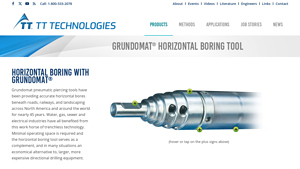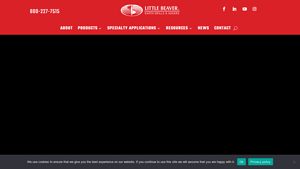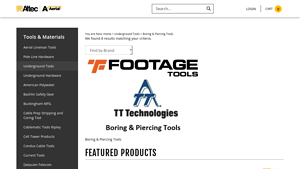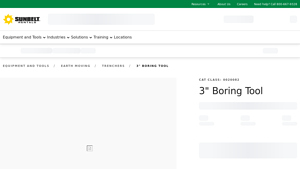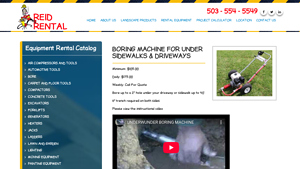Horizontal Boring Tool Guide: Type, Cost, Top List…
Introduction: Navigating the Global Market for horizontal boring tool
In the competitive landscape of global construction and infrastructure development, sourcing the right horizontal boring tools can be a significant challenge for businesses. With increasing demands for efficient underground installations, such as piping for utilities and irrigation systems, B2B buyers must navigate a myriad of options to find tools that not only meet their operational needs but also adhere to budget constraints. This comprehensive guide aims to demystify the horizontal boring tool market by examining various types, applications, and key factors to consider when selecting suppliers.
Throughout this guide, we will explore the diverse range of horizontal boring tools available, from pneumatic piercing devices to mechanical earth drills, each tailored for specific tasks and environments. Additionally, we will cover essential aspects of supplier vetting, ensuring that you partner with reputable manufacturers who provide quality and reliable equipment. Cost considerations will also be addressed, offering insights into pricing structures and potential return on investment.
By equipping international B2B buyers—particularly those from regions like Africa, South America, the Middle East, and Europe, including Brazil and Germany—with actionable insights, this guide empowers informed purchasing decisions. Whether you are upgrading your existing tools or investing in new technology, understanding the nuances of horizontal boring tools will enhance your operational efficiency and drive project success.
Understanding horizontal boring tool Types and Variations
| Type Name | Key Distinguishing Features | Primary B2B Applications | Brief Pros & Cons for Buyers |
|---|---|---|---|
| Handheld Boring Kits | Lightweight, portable, compatible with standard drills | Irrigation, electrical conduit installation | Pros: Cost-effective, easy to use. Cons: Limited to shorter runs. |
| Pneumatic Piercing Tools | Utilizes compressed air, designed for precision in tough terrains | Utility line installations, especially under roads | Pros: Efficient and fast, minimal surface disruption. Cons: Requires air supply and maintenance. |
| Mechanical Earth Drills | Versatile, can drill both vertically and horizontally | Landscaping, plumbing, and electrical installations | Pros: Multi-functional, suitable for various projects. Cons: Heavier and may require more setup time. |
| Horizontal Boring Machines | Fixed machines with precise control, capable of multiple spindle use | Industrial applications requiring high accuracy | Pros: High precision, suitable for mass production. Cons: Higher initial investment and space requirement. |
| Trenchless Technology Tools | Specialized for minimal excavation, often with modular components | Urban utility installations, roadworks | Pros: Reduces restoration costs, eco-friendly. Cons: Can be more expensive and complex to operate. |
What Are Handheld Boring Kits and Their Suitability for B2B Buyers?
Handheld boring kits are compact and user-friendly tools designed for quick underground installations. They typically connect to standard drills and are ideal for short runs of up to 100 feet. B2B buyers in sectors such as landscaping and electrical contracting can benefit from these kits due to their affordability and ease of use. However, their limited range may not suit larger projects, making it essential for buyers to assess their specific needs before purchasing.
How Do Pneumatic Piercing Tools Work and Why Are They Beneficial?
Pneumatic piercing tools leverage compressed air to create precise horizontal bores, making them excellent for challenging terrains like roads and railways. Their design minimizes surface disruption, which is a crucial factor for B2B buyers in utilities and construction. While these tools provide efficiency and speed, they require a reliable air supply and regular maintenance, which should be considered in the buying decision.
What Are the Key Features of Mechanical Earth Drills?
Mechanical earth drills are versatile machines capable of drilling in both horizontal and vertical orientations. They are particularly useful for landscaping and utility installations due to their adaptability. For B2B buyers, the multi-functional nature of these drills can streamline operations across various projects. However, their heavier build might necessitate additional manpower and setup time, influencing the overall project timeline.
Why Choose Horizontal Boring Machines for Industrial Applications?
Horizontal boring machines are fixed installations that offer high precision and are capable of using multiple spindle heads for increased productivity. These machines are ideal for industrial applications where accuracy is paramount, such as manufacturing and construction. While they provide significant benefits in terms of output quality, the higher upfront investment and space requirements can be a barrier for smaller businesses.
What Are Trenchless Technology Tools and Their Advantages?
Trenchless technology tools are designed for minimal excavation, making them suitable for urban environments where surface disruption must be minimized. They often feature modular components that allow for flexibility in installation. For B2B buyers in construction and municipal services, the reduced restoration costs and eco-friendly operation are attractive benefits. However, the complexity and potential higher costs associated with these tools may require careful consideration and planning.
Key Industrial Applications of horizontal boring tool
| Industry/Sector | Specific Application of horizontal boring tool | Value/Benefit for the Business | Key Sourcing Considerations for this Application |
|---|---|---|---|
| Construction | Installing utility lines under roads and pavements | Reduces surface disruption and restoration costs, enhancing efficiency | Durability, compatibility with existing equipment, and ease of use |
| Agriculture | Boring for irrigation systems | Allows for efficient water distribution, promoting crop yield | Size of bore required, soil conditions, and availability of local support |
| Telecommunications | Laying fiber optic cables | Facilitates quick and efficient installation, minimizing downtime | Length of bore, precision requirements, and local regulations |
| Landscaping and Gardening | Installing underground lighting and sprinkler systems | Enhances landscape aesthetics and functionality without surface damage | Depth and diameter specifications, soil type, and environmental impacts |
| Oil and Gas | Installing pipelines for gas and oil distribution | Ensures safe and efficient transport of resources | Compliance with safety standards, bore size, and pressure requirements |
How is Horizontal Boring Tool Used in Construction Projects?
In the construction industry, horizontal boring tools are essential for installing utility lines such as water, gas, and electricity beneath roads and pavements. These tools allow contractors to bore holes without disturbing the surface, significantly reducing restoration costs and time. Buyers in this sector must consider the durability of the equipment, compatibility with existing machinery, and overall ease of use, especially when working in urban environments where minimizing disruption is critical.
What Role Does Horizontal Boring Play in Agriculture?
Horizontal boring tools are widely used in agriculture for installing irrigation systems. By boring underground channels, farmers can efficiently distribute water to crops, which is crucial for maintaining high yields, particularly in regions prone to drought. When sourcing these tools, buyers should focus on the required bore size and adapt the tool to specific soil conditions. Additionally, having access to local support and maintenance services can significantly enhance operational efficiency.
How is Horizontal Boring Beneficial for Telecommunications?
In the telecommunications sector, horizontal boring tools are used to lay fiber optic cables, which are vital for high-speed internet access. The ability to bore under roads and other obstacles allows for quick installations with minimal service interruptions. B2B buyers in this field need to consider the length of the bore and the precision required for cable placement, as well as any local regulations that may affect installation processes.
Why is Horizontal Boring Important for Landscaping?
For landscaping and gardening projects, horizontal boring tools facilitate the installation of underground lighting and sprinkler systems without damaging the surface. This capability enhances both the aesthetic appeal and functionality of outdoor spaces. Buyers should specify the depth and diameter of the bore to ensure compatibility with their project needs, while also considering the impact of soil type on the boring process.
How Does Horizontal Boring Benefit the Oil and Gas Industry?
In the oil and gas sector, horizontal boring tools are crucial for installing pipelines that transport gas and oil. These tools help ensure safe and efficient resource transport, minimizing the risk of spills or leaks. When sourcing equipment, businesses must comply with safety standards and specify the bore size and pressure requirements to ensure that the pipeline can handle the operational demands of the industry.
3 Common User Pain Points for ‘horizontal boring tool’ & Their Solutions
Scenario 1: Difficulty in Selecting the Right Horizontal Boring Tool for Specific Applications
The Problem: B2B buyers often face challenges in selecting the appropriate horizontal boring tool for their specific applications. With numerous options available, including various types of kits and attachments, it can be overwhelming to determine which tool will best meet their operational needs. For instance, a construction firm planning to install irrigation pipes under a busy roadway may be unsure whether to choose a lightweight, portable kit or a more robust, heavier-duty model. Making the wrong choice can lead to inefficiencies, increased costs, and project delays.
The Solution: To effectively select the right horizontal boring tool, buyers should start by clearly defining their project requirements, including the type of pipe being installed, the soil conditions, and the distance to be bored. Researching manufacturers that specialize in horizontal boring tools, such as Borit or Bullet Mole, can provide valuable insights into the specifications and performance of different models. Engaging with suppliers for demonstrations or consultations can also help in understanding which tool would best serve their application. Additionally, buyers should consider the ease of maintenance and availability of spare parts when making their decision, ensuring long-term operational efficiency.
Scenario 2: Managing Downtime Due to Tool Malfunctions
The Problem: Unexpected downtime caused by tool malfunctions can significantly affect project timelines and budgets. Many B2B buyers may experience issues with their horizontal boring equipment, such as jammed bits or air compressor failures, especially if they are using outdated or poorly maintained tools. This situation not only leads to increased costs for repairs but can also result in lost contracts if projects are delayed.
The Solution: To minimize downtime, it is crucial for buyers to invest in high-quality horizontal boring tools that are designed for durability and reliability. Regular maintenance is essential; buyers should implement a routine inspection schedule to check for wear and tear, lubricate moving parts, and replace worn-out components before they lead to malfunctions. Additionally, establishing a relationship with a reliable supplier for quick access to replacement parts can expedite repairs. Training operators on proper usage and maintenance can also enhance tool longevity and performance, ultimately reducing the risk of unexpected failures.
Scenario 3: High Costs Associated with Trenching and Surface Restoration
The Problem: Traditional trenching methods can be costly and disruptive, especially when projects involve boring under roads, sidewalks, or other surfaces that require restoration post-installation. B2B buyers often face challenges in managing these costs, as excavation can lead to additional expenses for surface repairs and traffic disruptions. This is particularly concerning for companies operating in urban environments where compliance with regulations and minimizing public inconvenience are critical.
The Solution: Horizontal boring tools offer a trenchless solution that significantly reduces surface disruption and restoration costs. By opting for directional boring technology, buyers can install utilities with minimal excavation, preserving the existing landscape and infrastructure. When selecting tools, buyers should look for models that provide sufficient power and precision for their specific project conditions. Additionally, investing in advanced technology that allows for real-time tracking of the boring process can enhance accuracy and efficiency. Collaborating with experienced contractors who specialize in trenchless technology can further ensure successful project execution while keeping costs manageable.
Strategic Material Selection Guide for horizontal boring tool
What Are the Key Materials Used in Horizontal Boring Tools?
When selecting materials for horizontal boring tools, it is essential to consider their properties, advantages, and limitations. The right material can significantly influence the tool’s performance, durability, and suitability for specific applications. Here, we analyze four common materials used in horizontal boring tools: carbon steel, stainless steel, high-speed steel (HSS), and alloy steel.
How Does Carbon Steel Perform in Horizontal Boring Tools?
Key Properties: Carbon steel is known for its high tensile strength and hardness. It typically has a temperature rating of up to 400°F (204°C) and can withstand moderate pressure.
Pros & Cons: Carbon steel is cost-effective and readily available, making it a popular choice for manufacturing boring tools. However, it is prone to corrosion and may require protective coatings, which can increase manufacturing complexity. While it offers good durability, its susceptibility to rust limits its use in harsh environments.
Impact on Application: Carbon steel tools are suitable for boring through softer soils and materials but may not perform well in corrosive environments or when boring under water or in humid conditions.
Considerations for International Buyers: Buyers in regions like Africa and South America should ensure compliance with local standards for carbon steel tools, such as ASTM A36. In Europe, DIN standards may apply, and buyers should be aware of the potential need for protective coatings to enhance corrosion resistance.
What Are the Advantages of Stainless Steel in Boring Tools?
Key Properties: Stainless steel is renowned for its excellent corrosion resistance, making it suitable for various environments. It can handle temperatures up to 800°F (427°C) and is often used in applications involving water or chemical exposure.
Pros & Cons: The primary advantage of stainless steel is its durability and resistance to rust, which extends the lifespan of the tool. However, it is more expensive than carbon steel and can be more challenging to machine, increasing manufacturing costs.
Impact on Application: Stainless steel boring tools are ideal for applications in the water, gas, and sewage industries, where exposure to moisture and corrosive substances is common.
Considerations for International Buyers: Buyers should look for compliance with standards like ASTM A240 for stainless steel. In regions like the Middle East, where high temperatures and humidity are prevalent, stainless steel tools may be preferred despite the higher cost.
Why Choose High-Speed Steel (HSS) for Boring Tools?
Key Properties: High-speed steel is designed to withstand high temperatures and maintain hardness during operation. It typically operates effectively at temperatures up to 1200°F (649°C).
Pros & Cons: HSS offers excellent wear resistance and is suitable for high-speed applications, making it ideal for precision boring. However, it is more expensive than carbon steel and requires careful handling to avoid chipping.
Impact on Application: HSS tools are particularly effective in applications requiring precision and speed, such as boring through tough materials or in high-volume production settings.
Considerations for International Buyers: International buyers should ensure that HSS tools meet standards like ASTM A600. In Europe, compliance with EN standards is essential, and buyers should consider the availability of HSS tools in their local markets.
What Role Does Alloy Steel Play in Horizontal Boring Tools?
Key Properties: Alloy steel is engineered to provide enhanced properties, such as improved strength, toughness, and wear resistance. It can handle high temperatures and pressures, making it versatile for various applications.
Pros & Cons: The main advantage of alloy steel is its balance of cost and performance, offering greater durability than carbon steel without the high price of stainless steel. However, the complexity of manufacturing alloy steel tools can lead to longer lead times.
Impact on Application: Alloy steel tools are suitable for heavy-duty applications and can be used in challenging environments, such as rocky soils or areas with high abrasion.
Considerations for International Buyers: Buyers should verify compliance with standards like ASTM A829 for alloy steel. In Europe, DIN standards apply, and buyers should assess the availability of alloy steel tools in their specific regions.
Summary Table of Material Selection for Horizontal Boring Tools
| Material | Typical Use Case for horizontal boring tool | Key Advantage | Key Disadvantage/Limitation | Relative Cost (Low/Med/High) |
|---|---|---|---|---|
| Carbon Steel | Boring in soft soils | Cost-effective and readily available | Prone to corrosion | Low |
| Stainless Steel | Water and gas industry applications | Excellent corrosion resistance | Higher cost and machining complexity | High |
| High-Speed Steel | Precision boring in tough materials | Superior wear resistance | Expensive and prone to chipping | Med |
| Alloy Steel | Heavy-duty applications | Balanced cost and performance | Longer lead times due to complexity | Med |
This strategic material selection guide provides B2B buyers with critical insights into the materials used in horizontal boring tools, helping them make informed purchasing decisions based on their specific applications and regional requirements.
In-depth Look: Manufacturing Processes and Quality Assurance for horizontal boring tool
What Are the Main Stages of Manufacturing Horizontal Boring Tools?
The manufacturing process for horizontal boring tools involves several key stages, each critical to ensuring the final product meets the demands of durability and precision.
-
Material Preparation: High-quality raw materials, typically hardened alloy steels, are chosen for their strength and wear resistance. The selection of materials is crucial as it directly influences the tool’s longevity and performance. Suppliers should provide certifications for the materials used, ensuring they meet industry standards.
-
Forming: This stage involves shaping the raw materials through processes such as forging, machining, or casting. Precision machining is often employed to create the exact specifications required for the tool components, including the chisel and body. Advanced CNC (Computer Numerical Control) machines are frequently used, allowing for high precision and repeatability in production.
-
Assembly: After individual components are manufactured, they are meticulously assembled. This may involve integrating various parts like pneumatic systems, seals, and drill bits. Modular construction is a common approach, allowing for easier repairs and upgrades, which can be a selling point for international buyers seeking long-term value.
-
Finishing: The final stage includes surface treatments such as coating or polishing to enhance durability and reduce friction. Techniques like Teflon® coating are used to ensure smooth operation and to prevent metal-to-metal contact, which can lead to wear. The finishing process is critical for ensuring the tool performs optimally in diverse environments.
How Is Quality Assurance Implemented in Horizontal Boring Tool Manufacturing?
Quality assurance (QA) is vital in ensuring that horizontal boring tools meet both international standards and customer expectations. Here’s a closer look at how quality is maintained throughout the manufacturing process.
-
International Standards: Compliance with standards such as ISO 9001 is essential for manufacturers targeting international markets. ISO 9001 sets out criteria for a quality management system, emphasizing a process approach and continuous improvement. Adherence to these standards can increase a supplier’s credibility and facilitate smoother transactions in global markets.
-
Industry-Specific Certifications: Depending on the application of the boring tools, additional certifications may be necessary. For instance, CE marking is required for products sold in Europe, ensuring they meet safety and environmental standards. Manufacturers may also seek API (American Petroleum Institute) certification for tools used in oil and gas sectors.
What Are the Key Quality Control Checkpoints in the Manufacturing Process?
Quality control (QC) is integrated at several checkpoints throughout the manufacturing process to ensure that defects are identified and rectified early.
-
Incoming Quality Control (IQC): This initial checkpoint involves inspecting raw materials upon delivery. Suppliers should provide material certificates, and random samples may be tested to verify compliance with specified standards.
-
In-Process Quality Control (IPQC): During the manufacturing process, tools and machinery are regularly calibrated, and samples are taken at various stages to ensure adherence to design specifications. This may involve dimensional checks using precision measuring instruments and visual inspections for any visible defects.
-
Final Quality Control (FQC): Once assembly is complete, the final products undergo rigorous testing. This includes functionality tests to ensure that the tools operate as intended and stress tests to simulate real-world conditions. Documentation of these tests should be provided to buyers, enhancing transparency.
What Testing Methods Are Commonly Used to Validate Horizontal Boring Tools?
Several testing methods are employed to validate the performance and durability of horizontal boring tools:
-
Hydraulic Pressure Testing: This method assesses the integrity of the tool’s seals and connections, ensuring there are no leaks that could compromise performance.
-
Operational Testing: Tools are often tested in real-world conditions to evaluate their efficiency, speed, and effectiveness in boring operations. Feedback from these tests can lead to improvements in design and functionality.
-
Material Testing: Hardness tests and tensile strength tests are conducted to ensure that the materials used can withstand the operational stresses they will encounter.
How Can B2B Buyers Verify Supplier Quality Control Processes?
International B2B buyers must take proactive steps to verify the quality control processes of their suppliers to ensure they are receiving reliable products:
-
Supplier Audits: Conducting regular audits of suppliers can provide insights into their manufacturing processes and quality control measures. These audits should assess compliance with international standards and industry-specific certifications.
-
Requesting Quality Reports: Buyers should request detailed QC reports, including results from IQC, IPQC, and FQC tests. These documents offer transparency regarding the manufacturing process and product reliability.
-
Third-Party Inspections: Engaging third-party inspection services can provide an unbiased evaluation of the manufacturing and quality control processes. This is particularly important when dealing with suppliers in regions with varying standards of quality assurance.
What Are the Quality Control Nuances for International B2B Buyers?
When sourcing horizontal boring tools internationally, buyers from regions such as Africa, South America, the Middle East, and Europe should be aware of certain nuances:
-
Cultural Differences in Quality Standards: Understanding local manufacturing practices and quality perceptions can help buyers set realistic expectations. It is essential to communicate clearly about quality requirements and ensure that suppliers are aligned with these expectations.
-
Regulatory Compliance: Different regions have varying regulatory requirements. For instance, products sold in Europe must meet CE marking requirements, while those in the Middle East may need to comply with specific local standards. Buyers should ensure suppliers are familiar with and compliant with these regulations.
-
Logistics and Supply Chain Considerations: Quality assurance doesn’t end with manufacturing. Buyers should consider how transportation and handling might affect the integrity of the tools. Ensuring that suppliers have robust logistics processes can help maintain quality from production to delivery.
By understanding these manufacturing processes and quality assurance measures, B2B buyers can make informed decisions when selecting horizontal boring tools, ensuring they receive products that meet their operational requirements and standards.
Practical Sourcing Guide: A Step-by-Step Checklist for ‘horizontal boring tool’
Introduction
This practical sourcing guide is designed to assist B2B buyers in navigating the procurement process for horizontal boring tools. With the growing demand for trenchless technology across various industries, understanding how to effectively source the right equipment is essential for ensuring operational efficiency and cost-effectiveness.
Step 1: Define Your Technical Specifications
Before initiating your search, clearly outline the technical specifications required for your horizontal boring tool. Consider factors such as bore diameter, length of bore capability, and the type of materials you will be working with. Specifics like pneumatic versus hydraulic operation can significantly impact performance and suitability for your projects.
Step 2: Research Market Needs and Applications
Understanding the specific applications of horizontal boring tools in your industry can guide your procurement process. Tools are commonly used in landscaping, utility installations, and underground construction. Identifying the typical soil conditions and the types of installations (e.g., irrigation, electrical conduits) in your target markets can help in selecting the most appropriate tool for your needs.
Step 3: Evaluate Potential Suppliers
Before committing, it’s crucial to thoroughly vet potential suppliers. Look for companies that have a proven track record in your industry, and request case studies or references from similar projects. Make sure to assess their customer service and support options, as these can be critical during installation and operational phases.
- Consider Supplier Certifications: Verify if the suppliers hold relevant certifications and quality standards, such as ISO or CE marking, which can indicate reliability and adherence to industry benchmarks.
Step 4: Request and Compare Quotes
Once you have identified potential suppliers, request detailed quotes for the tools you are considering. Compare pricing, warranty terms, and maintenance services offered. Remember, the cheapest option may not always provide the best value; consider the total cost of ownership, including potential downtime or replacement costs.
Step 5: Assess Delivery and After-Sales Support
Timely delivery and robust after-sales support are critical factors in your sourcing decision. Inquire about the supplier’s logistics capabilities and expected delivery timelines. Additionally, ensure they offer adequate training and technical support, as this can greatly enhance the efficiency of your operations post-purchase.
Step 6: Negotiate Terms and Conditions
Engage in discussions with the selected supplier to negotiate favorable terms and conditions. This should include payment terms, return policies, and service agreements. A clear understanding of these terms can help prevent disputes and ensure a smoother transaction process.
Step 7: Finalize Your Purchase and Monitor Performance
Once you have agreed on terms, finalize your purchase. After receiving the horizontal boring tool, monitor its performance closely to ensure it meets your operational needs. Gather feedback from your team regarding usability and efficiency, which can inform future procurement decisions and supplier relationships.
By following this checklist, you can streamline your procurement process and ensure that you are making informed decisions that align with your business objectives.
Comprehensive Cost and Pricing Analysis for horizontal boring tool Sourcing
What Are the Key Cost Components for Horizontal Boring Tools?
Understanding the cost structure of horizontal boring tools is essential for B2B buyers aiming to make informed purchasing decisions. The primary cost components include materials, labor, manufacturing overhead, tooling, quality control (QC), logistics, and profit margin.
-
Materials: High-quality materials such as hardened alloy steel and Teflon® seals are often used in the production of horizontal boring tools. The choice of materials directly impacts both the durability of the tools and their pricing. Tools made from premium materials typically command higher prices but offer longer lifespans and reduced maintenance costs.
-
Labor: Skilled labor is crucial in manufacturing these tools. Labor costs can vary significantly based on the region and the complexity of the tool being produced. Countries with higher labor costs may produce more expensive tools, but they may also offer superior craftsmanship.
-
Manufacturing Overhead: This includes the costs associated with running the production facilities, such as utilities, rent, and administrative expenses. Manufacturers often factor these costs into the final pricing of the tools.
-
Tooling: Custom tooling can be required for specialized or high-volume production runs. This initial investment can be substantial, affecting the overall cost structure, especially for customized tools.
-
Quality Control (QC): Ensuring that tools meet international standards and certifications involves additional costs. Rigorous QC processes can lead to higher prices but also reduce the risk of defects, enhancing the tool’s reliability.
-
Logistics: Shipping and handling costs can vary based on the distance and mode of transport. For international buyers, understanding the logistics costs, including customs duties and tariffs, is critical.
-
Margin: Manufacturers typically include a profit margin that reflects their business model and market positioning. This margin can vary widely among suppliers based on brand reputation, market demand, and competition.
How Do Price Influencers Impact Sourcing Decisions for Horizontal Boring Tools?
Several factors influence pricing, and being aware of these can aid buyers in negotiating better deals.
-
Volume/MOQ: The minimum order quantity (MOQ) can significantly affect pricing. Bulk purchases often yield discounts, which can lead to substantial savings.
-
Specifications and Customization: Custom specifications can lead to increased costs due to the need for specialized materials or tooling. Buyers should evaluate whether the customization is necessary for their applications or if standard options suffice.
-
Materials: The choice of materials directly impacts the price. High-performance materials may incur higher upfront costs but can lead to lower long-term expenses due to durability and reduced maintenance.
-
Quality and Certifications: Tools that meet stringent quality certifications or industry standards may be priced higher. However, investing in certified tools can save costs related to downtime and repairs in the long run.
-
Supplier Factors: Different suppliers may offer varying prices based on their production capabilities, geographical location, and market positioning. It’s advisable to compare multiple suppliers and their offerings.
-
Incoterms: Understanding Incoterms is crucial for international buyers. These terms dictate shipping responsibilities and risks, which can impact the total landed cost of the tools.
What Buyer Tips Can Enhance Cost-Efficiency When Sourcing Horizontal Boring Tools?
-
Negotiation: Engage suppliers in discussions about pricing, especially for larger orders. Many suppliers are willing to negotiate terms, especially if they see potential for ongoing business.
-
Total Cost of Ownership (TCO): Consider not just the initial purchase price but also the TCO, which includes maintenance, downtime, and potential replacement costs. Tools with a higher upfront cost may be more economical over their lifespan.
-
Pricing Nuances for International Buyers: Buyers from regions like Africa, South America, the Middle East, and Europe should be aware of currency fluctuations, tariffs, and shipping costs, which can affect overall pricing. Establishing relationships with local distributors can also facilitate better pricing.
-
Research and Compare: Conduct thorough market research to understand the average pricing for various models and manufacturers. Utilize online resources and industry contacts to gather insights and make informed decisions.
Disclaimer
The prices mentioned are indicative and may vary based on market conditions, supplier negotiations, and specific buyer requirements. Always consult with suppliers for the most accurate and current pricing information.
Alternatives Analysis: Comparing horizontal boring tool With Other Solutions
Understanding Alternatives in Horizontal Boring Solutions
When evaluating the best options for underground installations, it’s essential to consider various solutions beyond the traditional horizontal boring tool. These alternatives can provide different advantages depending on the specific needs of a project, such as cost-effectiveness, efficiency, and ease of use. This analysis will compare horizontal boring tools with two viable alternatives: directional drilling and trenching.
Comparison Table
| Comparison Aspect | Horizontal Boring Tool | Directional Drilling | Trenching |
|---|---|---|---|
| Performance | Effective for short runs up to 100 feet | High precision over longer distances | Suitable for large-scale installations |
| Cost | Moderate initial investment | Higher upfront costs and operational expenses | Lower initial cost, but higher labor costs |
| Ease of Implementation | Simple setup and operation | Requires trained personnel and equipment | Labor-intensive and requires more space |
| Maintenance | Low maintenance; easy to handle | Moderate maintenance; equipment-specific | High due to wear and tear on machinery |
| Best Use Case | Ideal for residential and small commercial projects | Best for larger industrial projects or utilities | Suitable for extensive utility installation |
Detailed Breakdown of Alternatives
What Are the Advantages and Disadvantages of Directional Drilling?
Directional drilling is a method that utilizes advanced technology to drill horizontally at various angles, making it suitable for long-distance installations. One of the significant advantages of directional drilling is its precision and ability to navigate around obstacles, making it ideal for complex urban environments. However, the initial investment in equipment and the need for specialized training for operators can make it a costly option. Additionally, while it offers excellent performance for large projects, it may not be necessary for smaller installations where a horizontal boring tool could suffice.
How Does Trenching Compare to Horizontal Boring?
Trenching involves digging a trench to lay pipes or cables directly. This method is often seen as more straightforward and less expensive in terms of initial investment. However, trenching is labor-intensive, requiring more manpower and equipment to manage the excavation and restoration of the surface. It can also lead to significant disruption of the surrounding area, which is a critical consideration in urban settings. While trenching is effective for large-scale projects, the operational costs can escalate due to labor and potential environmental restoration efforts.
How Can B2B Buyers Choose the Right Solution?
In selecting the appropriate solution for underground installations, B2B buyers must evaluate their specific project requirements, including the scope, budget, and environmental considerations. For smaller, residential projects, horizontal boring tools may provide the best balance of cost and efficiency. For larger, more complex projects, directional drilling may be warranted despite its higher costs. Conversely, trenching could be the go-to option for straightforward installations where budget constraints are paramount, but buyers should be prepared for the associated labor and disruption costs. Ultimately, understanding the strengths and weaknesses of each method will empower buyers to make informed decisions that align with their operational goals.
Essential Technical Properties and Trade Terminology for horizontal boring tool
What Are the Essential Technical Properties of Horizontal Boring Tools?
Understanding the technical specifications of horizontal boring tools is crucial for B2B buyers looking to invest in effective and reliable equipment. Here are some key properties to consider:
-
Material Grade
The material used in the construction of horizontal boring tools significantly impacts durability and performance. Common materials include hardened alloy steel and high-carbon steel, which provide strength and resistance to wear. For buyers, selecting tools made from high-grade materials ensures longevity, reducing maintenance costs and downtime. -
Bore Diameter
The bore diameter indicates the size of the hole that the tool can create. Standard sizes range from 2 to 4 inches, depending on the application. Understanding bore diameter is essential for buyers to ensure compatibility with the pipes or conduits being installed. A precise bore diameter minimizes the risk of obstructions and enhances the efficiency of the installation process. -
Maximum Operating Pressure
This specification refers to the highest pressure at which the tool can operate safely. It is critical for pneumatic boring tools, where air pressure is utilized for operation. Buyers should consider the operating pressure to ensure the tool aligns with their project requirements, particularly in applications involving heavy-duty materials or challenging soil conditions. -
Weight and Portability
The weight of horizontal boring tools affects their ease of transport and setup. Lighter tools may be easier to handle on job sites, whereas heavier models may offer enhanced stability and power. Buyers need to evaluate the trade-off between portability and performance based on the specific needs of their projects. -
Tolerance Levels
Tolerance refers to the acceptable limits of variation in the dimensions of the drilled hole. Tight tolerance levels are crucial in applications where precision is paramount, such as installing electrical conduits or gas lines. Understanding tolerance requirements helps buyers select tools that can meet their project’s specifications effectively. -
Auger Speed
This specification denotes the rotational speed of the auger, typically measured in RPM (revolutions per minute). Higher auger speeds can lead to faster drilling but may also increase wear on the tool. Buyers should consider the balance between speed and durability based on the materials they will be boring through.
What Are Common Trade Terms Related to Horizontal Boring Tools?
Familiarity with industry terminology is vital for B2B buyers to navigate procurement processes effectively. Here are some common terms:
-
OEM (Original Equipment Manufacturer)
OEM refers to companies that produce parts or equipment that may be marketed by another manufacturer. Understanding OEM relationships can help buyers identify quality suppliers and ensure they are purchasing genuine parts that meet industry standards. -
MOQ (Minimum Order Quantity)
MOQ is the smallest number of units that a supplier is willing to sell. This term is critical for buyers to understand, as it can influence purchasing decisions, especially for companies looking to optimize inventory levels without overcommitting resources. -
RFQ (Request for Quotation)
An RFQ is a formal request sent to suppliers to obtain pricing and terms for specific products or services. For buyers, submitting an RFQ is an essential step in the procurement process, allowing them to compare offers from different suppliers and make informed decisions. -
Incoterms (International Commercial Terms)
Incoterms define the responsibilities of buyers and sellers in international transactions, including shipping, insurance, and tariffs. Familiarity with these terms helps buyers understand their obligations and the risks associated with their purchases, facilitating smoother transactions. -
Trenchless Technology
This term refers to methods of installing underground utilities without disturbing the surface, including horizontal boring. Buyers should recognize this technology as it offers a less invasive and often more cost-effective solution for various applications. -
Directional Drilling
This technique involves drilling at specific angles to navigate around obstacles underground. Understanding directional drilling is crucial for buyers who require advanced solutions for complex installation projects, ensuring they select tools that meet their specific needs.
By grasping these essential properties and terms, B2B buyers can make informed decisions when purchasing horizontal boring tools, ultimately enhancing project efficiency and success.
Navigating Market Dynamics and Sourcing Trends in the horizontal boring tool Sector
What Are the Current Market Dynamics and Key Trends in the Horizontal Boring Tool Sector?
The global market for horizontal boring tools is experiencing significant growth, driven by the increasing demand for trenchless technology across various industries such as construction, utilities, and telecommunications. This method offers a cost-effective, efficient solution for underground installations, minimizing surface disruption and reducing labor costs. Emerging technologies, including automation and enhanced material durability, are reshaping the sector, allowing for more precise and faster installations. International B2B buyers, particularly in regions like Africa, South America, the Middle East, and Europe, are increasingly looking for versatile tools that can handle diverse applications, from utility installations to landscaping.
One notable trend is the rise of rental services for horizontal boring equipment. This model is becoming popular among businesses looking to minimize capital expenditure while accessing high-quality tools. Additionally, as businesses aim for operational efficiency, there’s a growing interest in integrated solutions that combine boring tools with advanced tracking and monitoring systems. This allows for better project management and resource allocation, particularly in large-scale projects prevalent in Brazil and Germany.
Furthermore, sustainability is emerging as a key consideration in sourcing decisions. Suppliers are now expected to demonstrate their commitment to environmental stewardship, which includes offering tools made from recyclable materials and implementing energy-efficient practices in manufacturing.
How Is Sustainability and Ethical Sourcing Impacting the Horizontal Boring Tool Market?
Sustainability has become a pivotal concern in the horizontal boring tool sector, as businesses increasingly recognize the environmental impacts of their operations. The use of trenchless technology significantly reduces the carbon footprint associated with traditional excavation methods, as it minimizes soil disruption and conserves existing landscapes. For B2B buyers, choosing tools manufactured with sustainable practices and materials is crucial. This includes sourcing from suppliers who adhere to ethical labor practices and demonstrate a commitment to reducing waste in their production processes.
Additionally, various certifications, such as ISO 14001 for environmental management, are becoming essential in the purchasing decision. Buyers are encouraged to seek out suppliers who are transparent about their sourcing practices and who utilize ‘green’ materials, such as recyclable metals and eco-friendly coatings. By aligning with suppliers who prioritize sustainability, businesses not only enhance their corporate responsibility profile but also appeal to an increasingly environmentally-conscious consumer base.
What Is the Historical Context of Horizontal Boring Tools and Their Evolution?
Horizontal boring tools have evolved significantly over the past few decades, transitioning from rudimentary manual devices to sophisticated, high-tech machinery. Initially, these tools were primarily used for simple applications such as installing irrigation systems. However, advancements in technology have expanded their capabilities, allowing for precision boring beneath roads, railways, and other obstacles.
The introduction of pneumatic and hydraulic systems has increased the efficiency and effectiveness of horizontal boring tools, making them indispensable in modern construction and utility projects. Today, these tools are designed with durability and versatility in mind, catering to a wide range of industries and applications. The shift towards trenchless technology reflects a broader trend in the construction industry towards minimizing environmental impact while maximizing operational efficiency, highlighting the ongoing evolution of horizontal boring tools in meeting contemporary market demands.
Frequently Asked Questions (FAQs) for B2B Buyers of horizontal boring tool
-
How do I choose the right horizontal boring tool for my project?
Choosing the right horizontal boring tool depends on several factors, including the type of material you are boring through, the diameter of the bore, and the distance required. Consider the tool’s power source (electric or pneumatic), weight, and portability, especially if you’ll be working in tight spaces. Additionally, review the manufacturer’s specifications for maximum bore length and diameter. It’s also beneficial to assess the tool’s ease of use and maintenance requirements, as well as any attachments or accessories that may enhance its functionality for specific applications. -
What is the best horizontal boring tool for trenchless applications?
For trenchless applications, the Bullet Mole® and GRUNDOMAT® tools are highly regarded due to their efficiency and precision in underground boring. These tools facilitate the installation of utilities like pipes and cables without disturbing the surface, making them ideal for urban environments. The GRUNDOMAT® features a hardened alloy steel chisel for durability and a reciprocating stepped head for accurate targeting. Evaluate your specific project needs, such as bore length and soil conditions, to determine the best tool for your requirements. -
What are the minimum order quantities (MOQ) for horizontal boring tools?
Minimum order quantities can vary significantly by manufacturer and region. Typically, MOQs range from a single unit for smaller suppliers to several units for larger manufacturers. When sourcing tools, inquire directly with suppliers about their MOQs, as some may offer flexibility for first-time buyers or bulk orders. It’s also worth considering the potential for discounts on larger orders, which can enhance cost-effectiveness for your business. -
What payment terms should I expect when purchasing horizontal boring tools internationally?
International payment terms for purchasing horizontal boring tools can include options like wire transfers, letters of credit, and payment upon delivery. It’s essential to discuss and agree on payment terms upfront to avoid any misunderstandings. Many suppliers may require a deposit (often 30-50%) before production, with the balance due upon completion or shipment. Ensure that you also factor in currency exchange rates and any additional fees associated with international transactions. -
How do I ensure quality assurance when sourcing horizontal boring tools?
To ensure quality assurance, begin by vetting suppliers thoroughly. Look for manufacturers with established reputations, positive customer reviews, and relevant certifications (such as ISO 9001). Request samples or product demonstrations to evaluate performance firsthand. Additionally, inquire about their quality control processes, including testing and inspection procedures. Consider engaging a third-party inspection service if ordering large quantities or from unfamiliar suppliers to guarantee the tools meet your specifications. -
What logistics considerations should I keep in mind for international shipments of horizontal boring tools?
When planning for international shipments, consider factors such as shipping methods, import/export regulations, and potential tariffs. Choose a reliable logistics partner who specializes in heavy equipment to ensure safe and timely delivery. Factor in lead times for production and shipping, and discuss options for tracking shipments. It’s also wise to review the insurance coverage for the tools during transit, protecting your investment against potential damage or loss. -
Can horizontal boring tools be customized for specific applications?
Yes, many manufacturers offer customization options for horizontal boring tools to suit specific applications. Customizations can include adjustments to size, attachments for particular drilling tasks, or modifications to enhance performance in specific soil conditions. When discussing your requirements with suppliers, provide detailed information about your project to help them recommend suitable modifications. Be prepared to discuss lead times and any additional costs associated with custom orders. -
What maintenance is required for horizontal boring tools?
Regular maintenance is crucial for ensuring the longevity and performance of horizontal boring tools. This typically includes cleaning the tool after each use, checking for wear on bits and seals, and lubricating moving parts as recommended by the manufacturer. Inspect hoses and connections for leaks or damage before use. Additionally, follow any specific maintenance schedules provided in the user manual to prevent costly repairs and downtime, and ensure optimal operational efficiency.
Important Disclaimer & Terms of Use
⚠️ Important Disclaimer
The information provided in this guide, including content regarding manufacturers, technical specifications, and market analysis, is for informational and educational purposes only. It does not constitute professional procurement advice, financial advice, or legal advice.
While we have made every effort to ensure the accuracy and timeliness of the information, we are not responsible for any errors, omissions, or outdated information. Market conditions, company details, and technical standards are subject to change.
B2B buyers must conduct their own independent and thorough due diligence before making any purchasing decisions. This includes contacting suppliers directly, verifying certifications, requesting samples, and seeking professional consultation. The risk of relying on any information in this guide is borne solely by the reader.
Top 9 Horizontal Boring Tool Manufacturers & Suppliers List
1. Borit – Handheld Earth Boring Kits
Domain: borit.com
Registered: 1999 (26 years)
Introduction: This company, Borit – Handheld Earth Boring Kits, is a notable entity in the market. For specific product details, it is recommended to visit their website directly.
2. Bullet Mole – Horizontal Drilling and Boring Tools
Domain: bulletmole.com
Registered: 2003 (22 years)
Introduction: Bullet Mole Horizontal Drilling, Boring, Trenching, and Piercing Tools. Designed for installing irrigation and copper pipes, electrical and data conduits, and polyethylene gas lines under sidewalks, driveways, pavements, and roads. Marketed as the fastest, easiest, and most cost-effective solution for directional or horizontal drilling, boring, trenching, or piercing.
3. TT Technologies – GRUNDOMAT® Horizontal Boring Tool
Domain: tttechnologies.com
Registered: 1996 (29 years)
Introduction: GRUNDOMAT® Horizontal Boring Tool by TT Technologies, Inc. is a pneumatic piercing tool designed for accurate horizontal bores beneath roads, railways, and landscaping. It operates in various displaceable soils and can bore lengths from 50 to 150 feet. Key features include: hardened alloy steel chisel for durability, reciprocating stepped head for target accuracy, modular construction, and Teflon®…
4. Little Beaver – Horizontal Boring Kits
Domain: littlebeaver.com
Registered: 1997 (28 years)
Introduction: Horizontal Boring Kits from Little Beaver include: 1. Sidewalk Boring Kit: – Bores up to 5 feet under sidewalks. – Includes a 5-foot auger with a 3-inch diameter bit, a horizontal drill key, and a 5-foot extension with a universal wiggle joint. 2. Driveway Boring Kit: – Ideal for boring up to 50 feet under driveways or parking lots. – Includes options for a 2-, 3-, or 4-inch water drill bit, a swi…
5. GRUNDOMAT – Horizontal Boring Tool
Domain: linemen-tools.com
Registered: 2007 (18 years)
Introduction: GRUNDOMAT Horizontal Boring Tool – Underground Piercing Tool. Available in 2″, 2.5″, 3″, and 4″ diameters. Constructed from nickel chromoly steel, CNC machined to exact tolerances, and fully heat treated for strength and wearability. Ideal for water, gas, and cable installations. No wear rings for reduced maintenance costs.
6. Reddit – Horizontal Boring Machines Insights
Domain: reddit.com
Registered: 2005 (20 years)
Introduction: Horizontal boring machines (HBMs) are significant for machining large and varied parts. Key considerations include: 1. Additional equipment may be needed, such as a 90-degree table and heavy-duty V blocks. 2. A quill in the spindle (referred to as the ‘W’ axis) is beneficial for increased clearance and compatibility with programmable boring heads. 3. Workholding can be challenging, often requiring…
7. Sunbelt Rentals – 3 Boring Tool
8. Reid Rental – Boring Machine
Domain: reidrental.com
Registered: 2009 (16 years)
Introduction: BORING MACHINE FOR UNDER SIDEWALKS & DRIVEWAYS – Minimum: $105.00, Daily: $175.00, Weekly: Call For Quote. Bore up to a 2″ hole under your driveway or sidewalk up to 40′. 6″ trench required on both sides. Prices are subject to change. Regularly serviced and maintained equipment.
9. Grizzly – G4185 Horizontal Boring Machine
Domain: grizzly.com
Registered: 1991 (34 years)
Introduction: {“Product Name”: “Grizzly G4185 Horizontal Boring Machine”, “Price”: “$2,469.00”, “Specifications”: {“Motor”: “2 HP, 220V, single-phase, 12A”, “Spindle Travel”: “3””, “Spindle Speed”: “3450 RPM”, “Maximum Strokes per Minute”: “12 at 90 PSI”, “Maximum Stock Width”: “7-1/2 in.”, “Drill Bit Type”: “RH threads”, “Drill Bit Capacity”: “9/16″”, “Air Requirements”: “0.5 CFM at 90 PSI”, “Table Travel, Ve…
Strategic Sourcing Conclusion and Outlook for horizontal boring tool
In the realm of horizontal boring tools, strategic sourcing is paramount for international B2B buyers seeking efficiency and cost-effectiveness. The diverse range of tools available—from handheld kits to advanced pneumatic systems—offers unique advantages tailored to various applications, such as utility installation and landscaping. By investing in high-quality tools, businesses can significantly reduce operational downtime and project costs, ensuring smoother workflows and enhanced productivity.
As markets evolve, especially in regions like Africa, South America, the Middle East, and Europe, there is a growing emphasis on trenchless technology that minimizes surface disruption. This trend presents an opportunity for buyers to leverage innovative solutions that not only meet current demands but also anticipate future needs in infrastructure development.
Looking ahead, the horizontal boring tool market is poised for growth, driven by advancements in technology and increasing infrastructure projects globally. We encourage international buyers to engage with trusted suppliers, explore the latest product offerings, and consider the long-term benefits of strategic sourcing to enhance their operational capabilities. Investing wisely today will pave the way for sustainable success in tomorrow’s competitive landscape.

